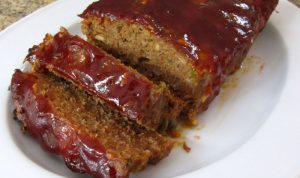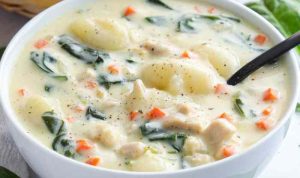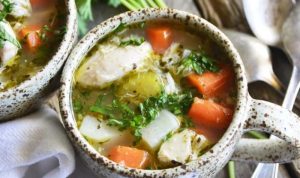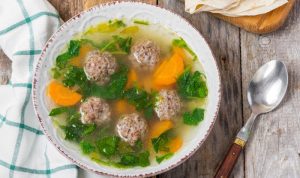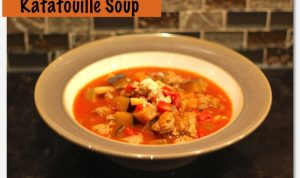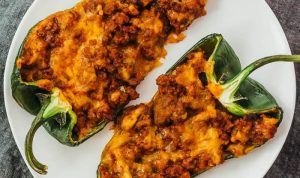Wonton Filling Variations
Wonton noodle soup recipe – The heart of any delicious wonton noodle soup lies in its filling. A well-crafted filling offers a delightful textural and flavor contrast to the delicate wonton wrapper and comforting broth. This section explores three distinct filling options: a classic pork filling, a savory vegetarian alternative, and a luxurious seafood choice. Each offers a unique culinary experience.
Wonton Filling Recipes
| Name | Ingredients | Instructions | Notes |
|---|---|---|---|
| Classic Pork Filling | Ground pork, finely chopped green onions, soy sauce, sesame oil, ginger, garlic, cornstarch | Combine all ingredients in a bowl. Mix thoroughly until well combined. | Adjust soy sauce to taste. For a richer flavor, consider adding a touch of Shaoxing rice wine. |
| Vegetarian Mushroom & Tofu Filling | Firm tofu (crumbled), finely chopped shiitake mushrooms, finely chopped carrots, soy sauce, sesame oil, cornstarch, garlic | Sauté mushrooms and carrots until softened. Combine with crumbled tofu, soy sauce, sesame oil, cornstarch, and garlic. Mix well. | Adding a pinch of black pepper enhances the savory notes. |
| Seafood Filling (Shrimp & Crab) | Cooked shrimp (chopped), cooked crab meat, finely chopped green onions, soy sauce, sesame oil, ginger, cornstarch | Gently combine all ingredients. Avoid overmixing to prevent the shrimp and crab from becoming mushy. | Use high-quality crab meat for the best flavor. |
Wonton Filling Comparison
The classic pork filling offers a rich, savory flavor with a slightly tender texture. The vegetarian option provides a hearty and umami-rich experience, with the mushrooms and tofu contributing a pleasant chewiness. The seafood filling delivers a delicate sweetness from the shrimp and crab, complemented by the subtle savory notes of the other ingredients. The textural contrast between the firm tofu/mushrooms and the tender pork/seafood further enhances the overall enjoyment.
Impact of Binding Agents
Binding agents, such as cornstarch and egg, play a crucial role in the texture of the wonton wrappers. Cornstarch provides a slightly chewier wrapper, while egg adds richness and helps bind the ingredients together, resulting in a more tender wrapper. The choice of binding agent can subtly alter the overall mouthfeel of the wonton.
Broth Preparation Techniques
The broth forms the foundation of a truly exceptional wonton noodle soup. Three distinct broth preparation methods are presented below, each offering a unique flavor profile to complement the chosen wonton filling.
Broth Preparation Methods
- Simple Chicken Broth:
- Combine chicken bones, water, ginger, and scallions in a large pot.
- Bring to a boil, then reduce heat and simmer for at least 2 hours.
- Strain the broth and season with salt and pepper to taste.
- Rich Pork Broth:
- Combine pork bones, water, ginger, garlic, and soy sauce in a large pot.
- Bring to a boil, then reduce heat and simmer for at least 3 hours.
- Strain the broth and season with salt and pepper to taste. Consider adding a touch of Shaoxing rice wine for extra depth.
- Vegetarian Kombu & Shiitake Broth:
- Combine dried kombu, dried shiitake mushrooms, and water in a large pot.
- Bring to a simmer, then reduce heat and simmer for at least 1 hour.
- Remove the kombu and mushrooms. Season with salt and pepper to taste.
Impact of Simmering Time
Simmering time directly impacts the depth of flavor in each broth. Longer simmering times extract more flavor from the bones and ingredients, resulting in a richer, more nuanced broth. For instance, a pork broth simmered for 4 hours will have a significantly deeper flavor than one simmered for only 2 hours.
Broth Nutritional Comparison
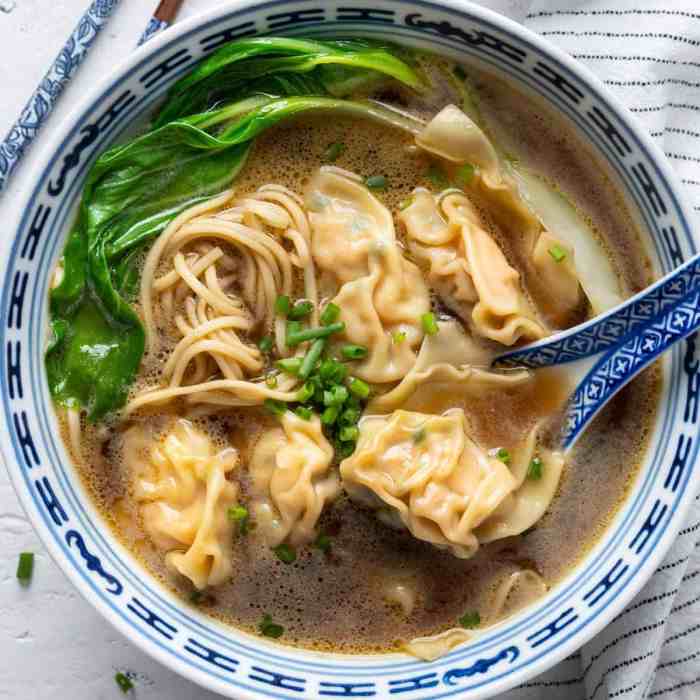
Source: elmundoeats.com
| Broth Type | Protein (g/serving) | Fat (g/serving) | Sodium (mg/serving) |
|---|---|---|---|
| Chicken Broth | Approx. 5-7 | Approx. 2-4 | Varies based on seasoning |
| Pork Broth | Approx. 8-10 | Approx. 5-7 | Varies based on seasoning |
| Vegetarian Broth | Approx. 1-2 | Approx. 1 | Varies based on seasoning |
Wonton Wrapper Options and Techniques: Wonton Noodle Soup Recipe
The choice of wonton wrappers and the folding technique significantly influence the final presentation and taste of the wonton noodle soup. This section explores both homemade and store-bought options, along with three distinct folding methods.
Homemade vs. Store-Bought Wrappers
Homemade wonton wrappers offer a superior texture and taste, often being more delicate and flavorful than store-bought options. However, making them from scratch requires time and skill. Store-bought wrappers provide convenience but might lack the same delicate texture and subtle flavor nuances.
Wonton Folding Techniques, Wonton noodle soup recipe
Three distinct pleating techniques are described below. Each provides a unique visual appeal.
- Simple Pleat: Fold the wrapper in half, creating a semi-circle. Place the filling in the center. Bring the edges together, pinching to seal. Repeat the pinching process along the edge to create a simple pleat.
- Fan Pleat: Fold the wrapper in half, creating a semi-circle. Place the filling in the center. Fold one side over the filling, then pleat the remaining edge, creating a fan-like shape. Pinch to seal.
- Flower Pleat: Fold the wrapper in half, creating a semi-circle. Place the filling in the center. Bring the two ends together, overlapping slightly. Pleat the edge around the filling, creating a flower-like design. Pinch to seal.
Cooking Time for Fresh vs. Frozen Wontons
| Wonton Type | Cooking Time (Boiling Water) |
|---|---|
| Fresh | 3-5 minutes |
| Frozen | 7-10 minutes |
Garnish and Serving Suggestions
The right garnish elevates the wonton noodle soup to a visually appealing and flavorful culinary experience. This section details several garnish options and serving suggestions.
Garnish Options
- Chopped Green Onions: Adds a mild onion flavor and vibrant green color.
- Cilantro: Provides a fresh, herbaceous note and adds a pop of color.
- Fried Garlic Croutons: Offers a crispy texture and intense garlic flavor.
- Sesame Seeds: Adds a nutty flavor and pleasing texture.
- Chili Oil: Provides a spicy kick and rich color.
Visually Appealing Presentation
A visually appealing presentation involves carefully arranging the wontons in the bowl, ensuring the broth is clear, and strategically placing the garnishes for color and textural contrast. Consider using a contrasting color bowl to highlight the soup’s ingredients.
Serving Styles
- Soup Bowls: Classic and practical, allowing for ample space for wontons and broth.
- Individual Ramekins: Perfect for elegant presentations or individual servings.
- Large Communal Bowl: Ideal for sharing among family or friends.
Recipe Adaptation and Customization
This section explores ways to adapt the wonton noodle soup recipe to accommodate various dietary needs and preferences.
Dietary Adaptations
For gluten-free options, use gluten-free wonton wrappers. To reduce sodium, use low-sodium soy sauce and carefully control the amount of salt added to the broth. For a low-fat version, use lean ground pork or chicken, and reduce the amount of oil used in cooking.
Vegetable and Protein Incorporation
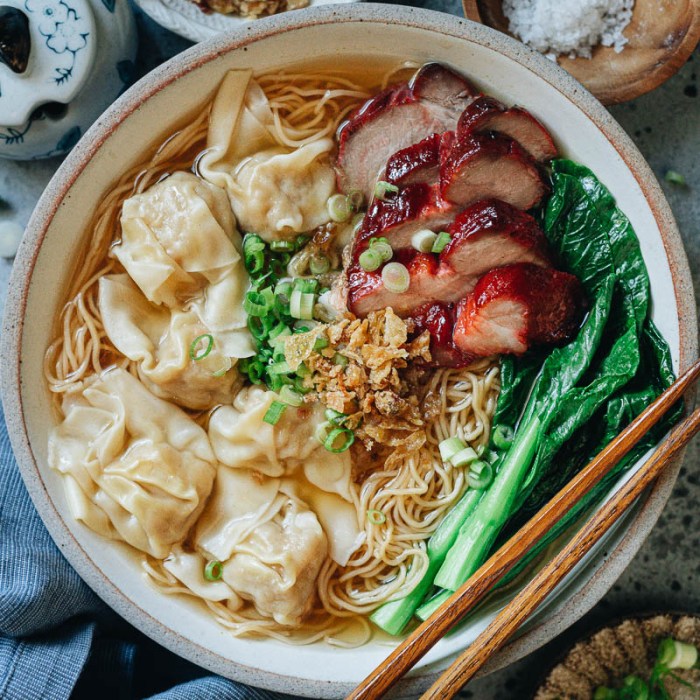
Source: omnivorescookbook.com
The recipe can easily accommodate various vegetables such as bok choy, spinach, or mushrooms. Additional protein sources like chicken, beef, or tofu can be added to the broth or incorporated into the wonton filling.
Flavor Pairings
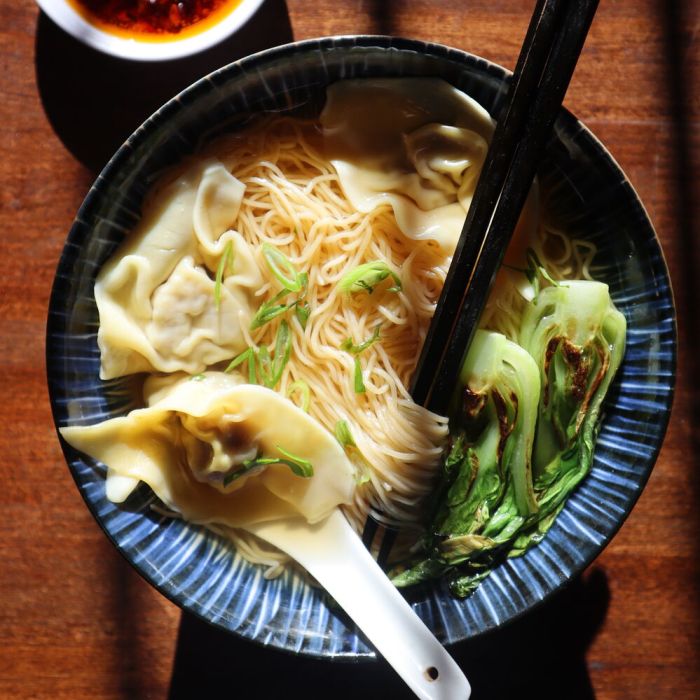
Source: thefeedfeed.com
Crafting the perfect wonton noodle soup requires careful attention to broth and noodle texture. For a lighter, spring-inspired alternative, consider a different approach, such as the delicious recipe for asparagus soup , which offers a vibrant, fresh flavor profile. Then, you can return to your wonton noodle soup recipe, perhaps incorporating some of the asparagus’s delicate elegance into the broth itself for an interesting twist.
- Chili Oil: Adds a spicy kick.
- Soy Sauce: Enhances the savory notes.
- Rice Vinegar: Provides a touch of acidity to balance the richness of the broth.
- Black Vinegar: Offers a unique tangy and slightly sweet flavor profile.
- Sesame Oil: Adds a nutty aroma and flavor.
Key Questions Answered
Can I use frozen wonton wrappers?
Yes, frozen wonton wrappers work well. Just ensure they are fully cooked according to package instructions.
How long can I store leftover wonton soup?
Leftover wonton soup can be stored in an airtight container in the refrigerator for up to 3 days.
What are some good substitutions for pork in the filling?
Chicken, ground turkey, or even chickpeas can be used as substitutes for pork in the wonton filling.
Can I make the broth ahead of time?
Yes, the broth can be made ahead of time and stored in the refrigerator for up to a week or frozen for longer storage.

